
Tenaya
September
2013
Part Two
Hermit Islands, PNG
| |
| HOME |
| About Tenaya |
| About Us |
| Latest Update |
| Logs from Current Year |
| Logs from Previous Years |
| Katie's View |
| Route Map |
| Links |
| Contact Us |
![]()
September 24, 2013
Three times during eight years of sailing we have come close to going aground and wrecking Tenaya. Two of those times happened here in the Hermit Islands of Papua New Guinea, two days apart.
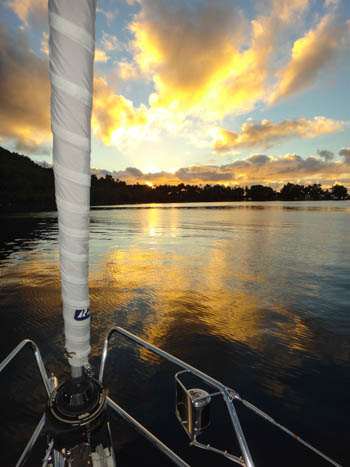
Although we met some nice people and enjoyed our time here, it is overshadowed by our drama in the anchorages. So, I'll tell those stories first. Get comfortable.

The Hermit Islands are surrounded by an outer reef and the island of Luf, our destination, is wrapped in its own reef while other bits of reef are scattered about. The coral is beautiful and easily visible in the clear water on a nice day. We hope for good light when entering the lagoon but it is overcast and we see dark clouds on the horizon and hear thunder.
The island is shaped like a barbell with bays on both sides of the narrow bar. The village is built along this low section while hills bursting with palms and other trees billow at each end.
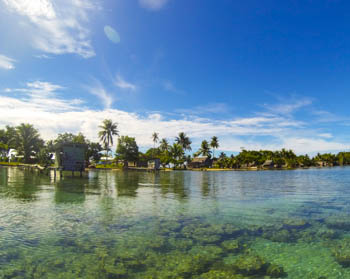
We head for Carola Bay in the south because it has the easiest access to the village. We dislike and distrust moorings but use them where there is coral or if requested by the locals. There are three moorings here and we chose the beefiest looking one. It is close to the reef and has a long, thick line that floats an entire boat length.
No sooner have we strung our lines through it than a squall hits and blows up to 27 knots. I wait at the bow in the pelting rain watching the line and our position to shore to be sure we don't blow back onto the reef while Jim is inside doing all our arrival stuff.
In an hour it's all over and we haven't budged. We are concerned that the line is so long, the reef is close and we are blowing that way. But all seems okay so we set the anchor alarm and go to sleep. We'll reassess in the morning. It is Sunday, Sept. 15.
The next morning Johnny comes out. His father was the first guide and set these moorings. He assures us ours is a big concrete block but he dives on all three to be sure the ropes are still strong. They are. We relax and settle in. That evening he brings us two painted crayfish and we give him a mask a friend left on board.
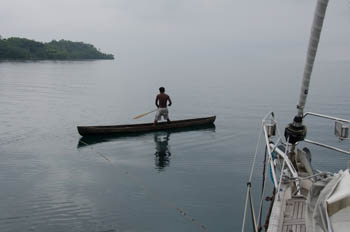
“These are some of the most remote and most beautiful islands in the world,” states the Imray Southeast Asia Cruising Guide about this area of Papua New Guinea. It's true. We see the first sailing yacht since we left Australia here in the anchorage. But the main mast is gone and the owner has abandoned it. It floats on a mooring close to shore. Arwin has claimed it although we hear it was left for the community.
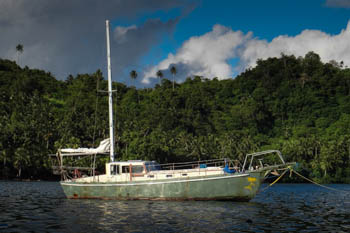
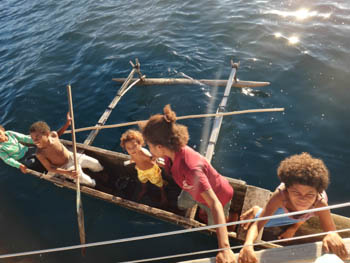
Thursday, Sept. 19. The forecast is for strong winds from the south and this anchorage will not be safe or comfortable. Johnny says he will come out at 0730 to show us the way to the north anchorage via Manta Pass. Our charts show no way through. The wind is blowing in the high 20s, the mooring line is stretched tight and our stern is two boat lengths from the reef. Chop tosses the boat up and down. As usual, Jim and I talk about what we will do. The plan: I drop the mooring, we float back just enough to clear it, Jim steers toward the tip of the island to leave the ball and line to starboard and we follow our track out through the other reefs.
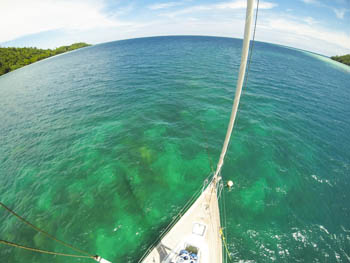
It is time and Johnny is nowhere in sight. Our lines are too tight for me to loosen so Jim motors ahead to give me some slack. By the time I drop the mooring we are even with the long, thick, floating line. Jim cannot see it. “Go to starboard,” I said. “No, go to port.” I am afraid he will turn quickly and pivot the stern into it. Instead we motor right over it. The word 'neutral' never comes out of my mouth.
The engine stalls. Shit! “Drop the anchor!” Jim shouts. Jim never shouts. Immediately Tenaya spins around, bow to the reef two boat lengths away. We are in five meters so I let out 20 meters of chain, too much to keep us off the reef if the mooring line gives way.
I snorkel under to have a look. Shit. Shit. Shit. Our girl had grabbed onto the mooring line and is holding tight. The thick mooring line is wrapped around the shaft and prop several times. A thinner line which is also attached to the ball and to a bommie is wrapped on top of it. A bit of fishing net covered in growth waves like a flag at the end of yet another line. Baby black-tail sergeants dart about. We photo document just about everything and I consider asking for my camera. This is a cool shot in a 'this really sucks' kind of way.
Jim gets one of our good 100 meter lines and I tie a rolling hitch to slacken the mooring line before Jim winches it in. The rolling hitch holds so we can pull up the anchor. As I roll in the chain, it sticks at five meters. Back in the water I go to free it from some coral. Good thing we do not need to rely on the anchor. It is just sitting on the bommie and would pull off into the mud. We would be on the reef before it sets.
For some reason I think I can cut through the lines. The knife simply slides on the slimy growth so the only option is to unwrap them. There is not enough slack to do it easily and I can't hold my breath very long. I undo one or two wraps before needing to surface while trying not to bang my head as the stern bounces up and down. Thank God for our folding Gori prop. I am able to twist, turn and flatten blades to ease the lines off.

“Here comes Johnny,” Jim says sounding like Ed MacMahon. I go back under and unwind the last wrap. “She's free,” I yell to Jim. He seems surprised. Johnny puts on his gear and slides into the water as his young son paddles their outrigger canoe back to shore. I am busy tying the short lines to the thick line and he dives to the bottom and unties the thin line also attached to the ball. He adds that to the thick, floating line. Now we only have to avoid this one big snakes wedding.
Again we talk about how to get clear. The plan: Put a sacrificial line on the mooring line so we can free our good 100 meter line and use the new one as a spring to steer the boat around. Then release it. The bow will not come around so Jim uses the bow thruster. It still won't come around. Oh yeah, we must back the boat into the wind… We’ve both forgotten this simple rule. Jim backs up, Johnny holds the mooring line away while I unwrap and toss the sacrificial blue line off. Whew, we're clear.
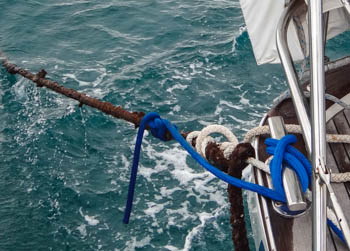
As we leave the anchorage, Johnny points out the reef where two American women sank their boat and wrote a book about their experience, misquoting and misrepresenting the local voices. Before we reach Manta Pass he points out a different reef that a French boat hit. The hull rests on the shore. A shiver runs down my spine.
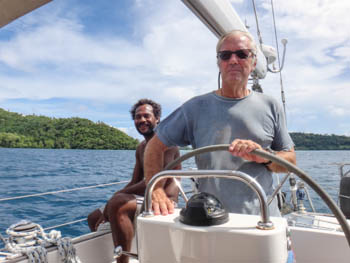
Our friend, Duncan, has given us a waypoint for an anchorage he says is ideal so we head for that. Johnny insists we anchor in front of his village instead and guides us to his favored spot. Now Tenaya is anchored in 8 meters on the northern side of the village near another reef. The water is calm, warm and crystal clear. The coral is spectacular. No wonder Jacques Cousteau liked this area. We would never drop our anchor on a healthy reef; why on Earth did we listen? We are angry with ourselves and feel horrible. But it is tranquil and we stay.
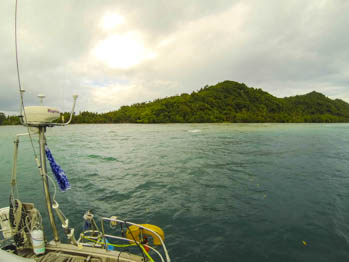
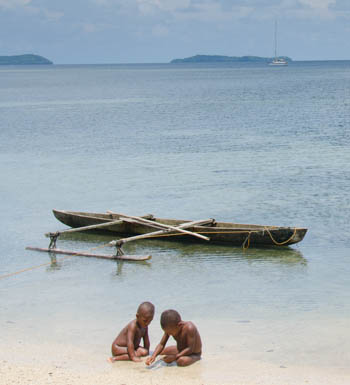
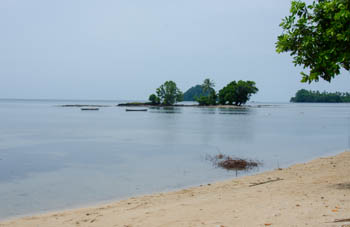
Arwin, Frieda and Troy come to visit. As we tell stories a boat drives by. Frieda hails them, they come over, and she drills them on the fish they've caught. They bring out a lovely rainbow runner from underneath the pile and hand it up to her. She gives it to me. I ask what we should give them for it. "Nothing," she says. I look perplexed and she just shakes her head. Okay, she's the boss.
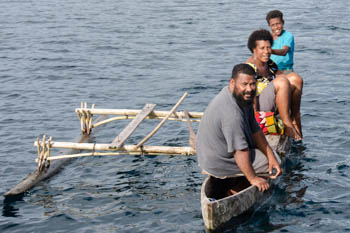
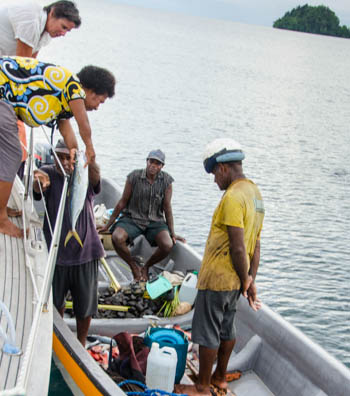
Sunday, September 22. With chocolate chip cookies and a pot of coconut rice we go ashore to meet Frieda for church and lunch with her family. As we listen to a sermon seated on a long, wooden bench a strong breeze begins to blow in through the slatted windows. White caps start to roll onto the reef. The wind had changed to NW. It's a bad direction for our position so close to the reef. Jim and I strain to see Tenaya.
Finally there is a break in the service and I tell Frieda that we are worried about the boat. She understands and tells us to go. We hurry out to reach Tenaya who is bouncing in the chop less than two boat lengths from the reef. Jim fires up the engine and I quickly gear up. When I am ready to jump in Johnny and his wife roar up in their banana boat. Johnny is over the side in no time. Underwater, we see the chain hooked in three places on the coral. The one holding us off the reef is straight down a wall from the bow. We are safe for the time being.
Jim sits at the chart table watching our track as we talk about our options. He watches the wind shift more from the west which frees the snag on the wall and lets Tenaya drift dangerously close to the reef. Time to leave, NOW. The wind is blowing 15-18 knots and the dark clouds are pouring rain. Jim turns on the engine and motors forward as I hurry to the bow. The chain alternates between coming up and getting stuck but we manoeuver around and before long the anchor is up.
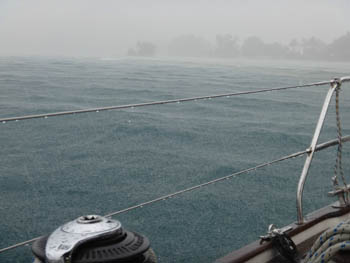
Off we go back around to Carola Bay where the wind is now offshore and the water calm. Instead of picking up a mooring, we anchor smack in the middle of the bay on mud in 32 meters. It is as far from a reef as we can get.
Tuesday Sept. 24. The wind is shifting to the SE again. We decide to leave the Hermits rather than going around to the other side again. It's 70 miles to Ninigo which also has an outer reef. It's too far to clear both reefs in good light so we're doing an overnighter. We begin hauling up the anchor at 3:00 pm. With 20 meters still out the windlass overheats and stops. I try to pull it up by hand but it doesn't budge. It's blowing 16 knots on shore and we begin drift down. I jump behind the wheel and Jim goes to the bow. He rigs the spinnaker halyard to a hook that fits on our 10mm chain and uses the anchor snubber to lock each length of chain. He runs the spinnaker halyard back to the SB primary winch and, on his say so, I wind it up.
All the while I'm driving back and forth trying to stay in the middle of the bay. Suddenly the reef that forms a golden barrier between the bay and the island seems really close in every direction.
I am thrilled when Jim comes back and says, "It's working, go up and finish pulling up the anchor." In the log book he writes: ENOUGH OF THIS!

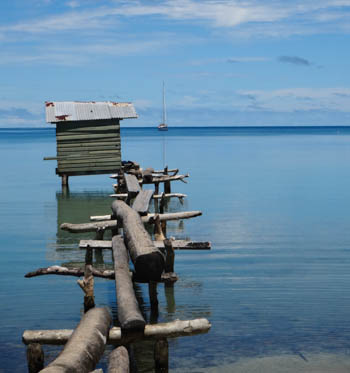
It was a three day trip from Kavieng to the Hermit Islands. Winds are in the single digits from behind and we motor the entire way. Lightning sparks in the distance and clouds roll over sometimes bringing rain, sometimes clearing to show millions of stars against the black sky. We pass big Asian fishing boats with skiffs corralling their nets. AIS says one is 188' long and 36' wide. It has a helicopter on deck.
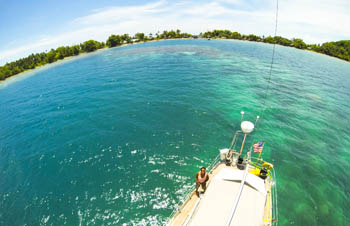
The next morning Baxter and Lorraine paddle out to greet us. Usually the local guide does this but he's at Ninigo with most of the other young men from the village. It is Independence Day and they are playing soccer.
We ask Baxter and Lorraine about buying diesel and they say Matthew will be leaving shortly for Manus Island and will be back in two days. They leave to ask if he will get fuel for us and a short time later he zooms up and takes our 4 jugs and 320 kina, saying he will return Wednesday. I give the group on board a bag of Werther's lollies for the trip. Jim frowns, they are his favorites.
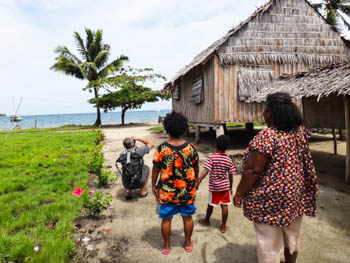
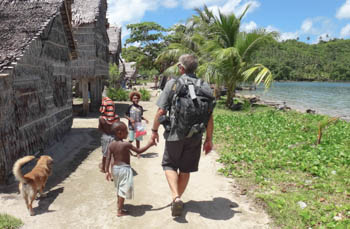
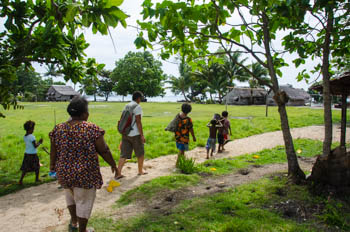
Baxter invites us to shore and leads us around the village introducing us to people. Global warming is already having an impact here - some people have had to build sea walls around their houses to keep the water out.
We meet friends of our friends, Duncan and Audre of Matsu. Frieda's and Wilma's smiles stretch from ear to ear at the mention of Audre's name and I get hugs that I am sure are meant for her.
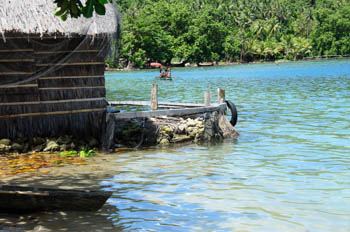
People give us the sweetest pawpaw, mangos, pineapples, bananas and oranges we've ever tasted. They ask for sugar, flour, rice and sewing material in return. We feel bad about taking food because Frieda says they have a problem with rats in the gardens. Big rats from Malaysia are eating their crops. Some people have small gardens in front of their houses in hopes the dogs and cats will keep the destructive pests away, but they cannot take the place of the large plots of land in the bush.
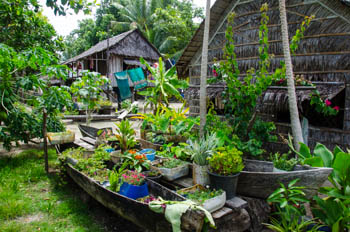

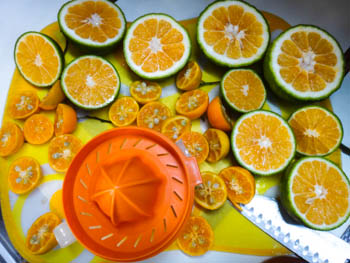
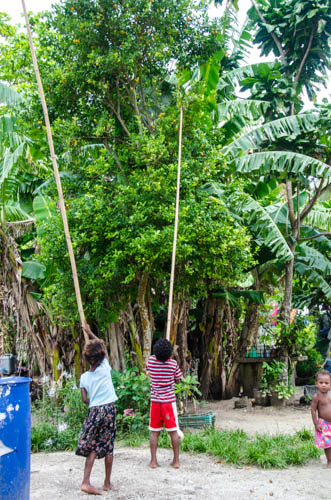
We accept only what we know we can eat but tell the people they get credit for all they offer. And we will take shells. We love shells! Evelyn is from an island near Manus where the ladies make baskets out of gum shells. She gives me one and then asks for my skirt. This Mountain Hardware skirt is my all-time favorite, with many pockets and a cool lining around the waist, so I say no. Instead I give her fabric and sewing supplies. Later we print a picture of her standing with her four boys and frame it. She gasps when she sees it and doesn't take her eyes off of it.



I tell Baxter and Lorraine my story about attempting to bake cassava (manioc) in the oven. They offer to come out the next day and teach me how to bake it correctly. The secret: plenty of coconut milk spooned periodically over the top to keep it moist. We eat it for lunch. It is delicious and I've got some leftovers. I show them how to bake banana bread and send them home with a warm loaf each and all the ingredients to make more. Lorraine teaches the sixth grade class so we give her a history book and two story books we bought in Kavieng as well as a world map. She and Baxter are both bright and energetic and we like them very much.

Lois and Joanne both have sewing machines that do not work. Jim tries to fix them but cannot. I suggest to Joanne that since Lois' machine is also broken, maybe we can get the part from hers to make one operable Singer. Both Joanne and her mother, Wilma, shake their heads. "She is my auntie but she will not help me," says Joanne. I think is odd and sad considering Lois is the preacher's wife.

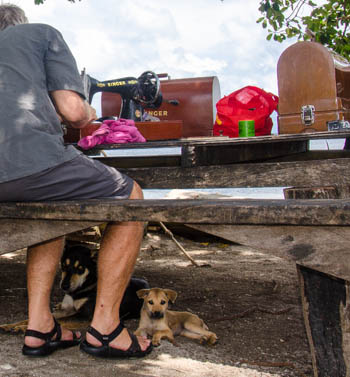
Each time we go ashore Robert and Roberta greet us and help us haul the dinghy up onto the beach. They guide us to wherever we are going and stay with us all day. Their parents are both at Ninigo playing soccer so their grandmother is watching over them.

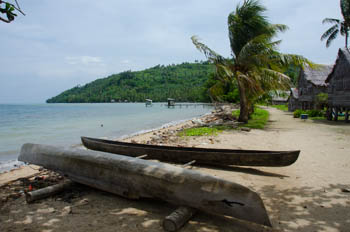



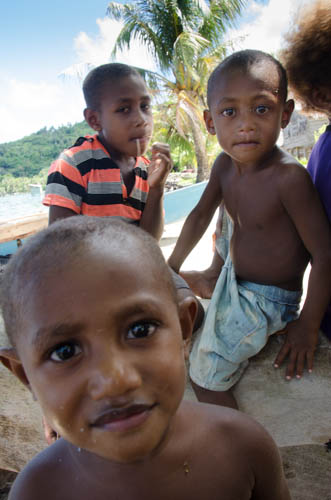
Although the Hermit Islands are remote, the people are connected to civilization by fast boats to Manus and yachties stopping on their way to or from Palau. This is the first island we've visited where the children are stopped from climbing trees for fear they will hurt themselves. But it is nice they have wooden benches to sit on. The ground gets hard after a while on our aging bones.
Go to September 2013, Part Three - Mal Island, Ninigo Islands, Papua New Guinea
